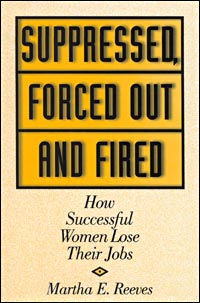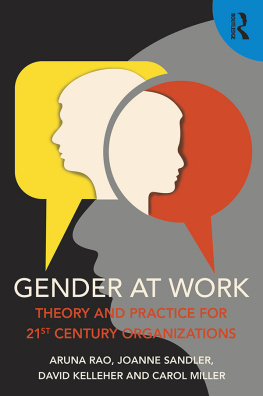Cover

| title | : | Suppressed, Forced Out and Fired : How Successful Women Lose Their Jobs |
| author | : | Reeves, Martha E. |
| publisher | : | Greenwood Publishing Group |
| isbn10 | asin | : | 1567203566 |
| print isbn13 | : | 9781567203561 |
| ebook isbn13 | : | 9780313000478 |
| language | : | English |
| subject | Sex discrimination in employment--Case studies, Women--Employment--Case studies. |
| publication date | : | 2000 |
| lcc | : | HD6060.R44 2000eb |
| ddc | : | 331.13/3 |
| subject | : | Sex discrimination in employment--Case studies, Women--Employment--Case studies. |
Page i
SUPPRESSED,
FORCED OUT
AND FIRED
Page ii
This page intentionally left blank.
Page iii
SUPPRESSED,
FORCED OUT
AND FIRED
How Successful Women Lose Their Jobs
Martha E. Reeves

Page iv
Library of Congress Cataloging-in-Publication Data
Reeves, Martha E., 1951
Suppressed, forced out and fired : how successful women lose their jobs / Martha E.
Reeves.
p. cm.
Includes bibliographical references and index.
ISBN 1567203566 (alk. paper)
1. Sex discrimination in employmentCase studies. 2. WomenEmploymentCase
studies. I. Title.
HD6060.R44 2000
331.13'3dc21 99056363
British Library Cataloguing in Publication Data is available.
Copyright 2000 by Martha E. Reeves
All rights reserved. No portion of this book may be reproduced, by any process or technique, without the express written consent of the publisher.
Library of Congress Catalog Card Number: 99056363
ISBN: 1567203566
First published in 2000
Quorum Books, 88 Post Road West, Westport, CT 06881
An imprint of Greenwood Publishing Group, Inc.
www.quorumbooks.com
Printed in the United States of America

The paper used in this book complies with the Permanent Paper Standard issued by the National Information Standards Organization (Z39.481984).
10 9 8 7 6 5 4 3 2 1
Page v
Contents
Acknowledgments | vii |
Chapter 1 Introduction | |
Chapter 2 Womens Subordination in the Workplace | |
Chapter 3 Understanding Womens Subordination | |
Chapter 4 Profiles of the Women | |
Chapter 5 Becoming Difficult: Women Managers Encounter Subordination | |
Chapter 6 Finally Forced Out | |
Chapter 7 Patriarchy and Personality | |
Chapter 8 The Present and the Future | |
Appendix: Research Methodology | |
Bibliography | |
Index | |
Page vi
This page intentionally left blank.
Page vii
Acknowledgments
I wish to thank the ten women who shared their experiences, which formed the basis of this book. I also want to thank Steve Jeffries, Wendy Richards, and Judi Marshall for their suggestions to improve the manuscript. Linda Wirth at the International Labour Organization provided me with valuable information. I am grateful to my children, Alex and Chris, who were patient with me as I juggled my work, their needs, and the research for this project. Finally, I wish to thank Alexander Rosenberg for his support and encouragement.
Page viii
This page intentionally left blank.
Page 1
CHAPTER 1
Introduction
Even in an age of equal opportunity legislation and workplace initiatives to make work more flexible and agreeable to women, women still occupy the lower rungs of the corporate ladder. Todays corporations spend a portion of their training budgets communicating employment law to managers, particularly laws concerning racial and sexual discrimination and how to prevent it, yet discrimination in the workplace continues. In spite of legal remedies in the United States (Title VII of the Civil Rights Act of 1964 and the Equal Pay Act of 1963) and in Britain (the Sex Discrimination Act of 1975 and the Equal Pay Act of 1970), inequities and power differences between men and women persist.
By examining the stories of ten middle and senior women managers, this book uncovers some of the mechanisms that make this entrenched discrimination possible. The women, after much investment in their careers, were forced out of their organizations. Through their experiences we come to understand how talented women are marginalized and eventually dismissed from organizations. As these women took exception to their treatment, their circumstances worsened. Their expressed concerns over equity were met with sexual harassment, bullying, and other forms of workplace intimidation. The women profiled in this book were employed in common fields such as human resources, finance, management consulting, marketing, engineering, and sales. They came from both the manufacturing and service sectors, representing companies in the financial services, retail, printing, aerospace, and food-processing areas. Having reached a level in their careers marked by a substantial amount of authority and responsibility, they
Page 2
expected to continue moving upward in their organizations. They managed staff, had responsibility for budgets, made decisions, and identified with a peer group of men of substantial rank. Many of them had made an effort to enhance their skills through attainment of a postgraduate qualification such as an MBA degree.
Career counseling companies, outplacement organizations, governmental agencies, national newspapers (where a few cases were highlighted), and managers of organizations in which the women worked helped me locate women who had been displaced from organizations. When I initially undertook this research, I simply wanted to find out how women experience job loss and how they adjust to change; I was not looking for or expecting to uncover gender discrimination. However, the stories of the inequities the women faced became so compelling and similar among the women that I could not ignore them. In addition, looking back to my own career in management with several organizations in both England and the United States I found the incidents of subtle (and not so subtle) inequalities in the workplace described by these women all too familiar. I had experienced the same type of communication stumbling blocks and all-male camaraderie that so often excludes women. I had found it difficult to break into all-male networks, gain access to information that seemed available to my male colleagues, and in meetings to be listened to as men listen to men. My own experiences and those of the women in this book have led me to examine whether or not real progress has been made since the early 1970s. Even though the 1990s has been a decade characterized by equal opportunity lawsuits, have the ways of discrimination simply become more subtle, covert, and underground?
Next page














